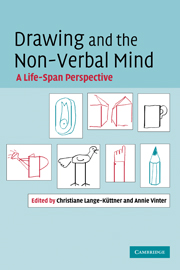Book contents
- Frontmatter
- Contents
- Contributors
- 1 Contemporary enquiries into a long-standing domain: Drawing research
- Part I Self, symbols and intention
- Part 2 Syntax, space systems and projection
- 7 The interaction of biomechanical and cognitive constraints in the production of children's drawing
- 8 Graphic syntax and representational development
- 9 Spatial structures in children's drawings: how do they develop?
- 10 Figures in and out of context: absent, simple, complex and halved spatial fields
- 11 Spatial and symbolic codes in the development of three-dimensional graphic representation
- 12 On contours seen and contours drawn
- Part III Aging, blindness and autism
- Index
- References
8 - Graphic syntax and representational development
Published online by Cambridge University Press: 22 September 2009
- Frontmatter
- Contents
- Contributors
- 1 Contemporary enquiries into a long-standing domain: Drawing research
- Part I Self, symbols and intention
- Part 2 Syntax, space systems and projection
- 7 The interaction of biomechanical and cognitive constraints in the production of children's drawing
- 8 Graphic syntax and representational development
- 9 Spatial structures in children's drawings: how do they develop?
- 10 Figures in and out of context: absent, simple, complex and halved spatial fields
- 11 Spatial and symbolic codes in the development of three-dimensional graphic representation
- 12 On contours seen and contours drawn
- Part III Aging, blindness and autism
- Index
- References
Summary
This chapter focuses specifically on the relationships between syntax and cognitive development, particularly representational development. Vinter, Picard and Fernandes promote the take-home message that changes in drawing behaviour during development result from changes in the size of the cognitive units or mental representations used to plan behaviour, and in the capacity to manage part–whole relationships. This hypothesis is first illustrated by reviewing studies in which children's adherence to the graphic rules when they copy elementary or complex figures is assessed. The authors also examine children's syntactical behaviour at a more global level, characterizing the entire drawing sequences built by children when they produce a drawing. Children's graphic strategies appear to reflect how they conceive of the patterns they reproduce. Task constraints (meaning given to the pattern, type of primes used to enhance specific strategies) contribute to modify their syntactical behaviour, but not uniformly throughout development. A three-step developmental model outlined in the first section of the chapter finds further support in studies dealing with procedural and representational flexibility. Finally, the authors report an original perspective on studying syntactical drawing behaviour, where it is shown that this behaviour can be incidentally modified through directed practice in children as well as in adults. By the way, the results reported by Vinter, Picard and Fernandes reveal the extent to which syntax constitutes a flexible component of drawing behaviour.
Information
- Type
- Chapter
- Information
- Drawing and the Non-Verbal MindA Life-Span Perspective, pp. 139 - 158Publisher: Cambridge University PressPrint publication year: 2008
References
Accessibility standard: Unknown
Why this information is here
This section outlines the accessibility features of this content - including support for screen readers, full keyboard navigation and high-contrast display options. This may not be relevant for you.Accessibility Information
- 7
- Cited by
